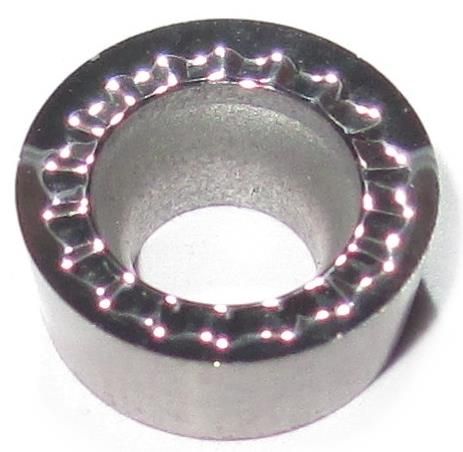If only someone wrote a guide for MEW 
From my series sponsored by Arc Euro Trade, for the pictures see MEW 264:
Insert Codes
There is a standard code for describing inserts, typically four letters followed by a number. The full code is too complex to detail here, so as an example let’s look at a typical insert that suits smaller lathes: CCGT 060204, photo 9:
Shape – C: 80-degree diamond, this give a well-supported tip that can work into a 90-degree corner. Some other useful shapes are S – square as shown in photo 6; R – round; T – equilateral triangle and V – a long-thin diamond shaped tool intended for CNC profile turning but useful for delicate work.
Clearance – C: 7-degrees; a good compromise between good support for the cutting edge and ample clearance.
Tolerance – G: This is the tolerance of various measurements of the insert. The tolerance letter can be confusing as the tolerance reflects other properties of the insert. The two you are most likely to encounter are G and M. M is a general use moulded insert, while G is ground further into specific shape (e.g. Top rake for additional tolerance for specific application, and so will cost more than the M moulded inserts. Both types are available coated for better wearing properties, or un-coated or polished for the G type. In the hobby environment, M type are generally used for machining of steel, stainless steel and cast iron. The polished G type with ground edges, are ideal for cutting aluminium, brass and other non-ferrous metals.
Hole/Chipbreaker – T: A 40-60-degree double countersunk hole (it has to match the screw used by your toolholder) and a single-sided chipbreaker.
Cutting edge length – 06: 6 millimetres, in this case one side of our diamond.
Thickness – 02: This is 3/32” or 2.38mm.
Corner radius – 04: In this case 0.4mm. For hobby machines corner or nose radius of 04 – 0.4mm (for finishing) or 08 – 0.8mm (for general use) are suggested. Finer radius than this, such as 00 – sharp point, 01 – 0.1mm and 02 – 0.2mm should generally be avoided as they are more suited for use at very high speeds on industrial CNC machines with high rigidity. If used on hobby machines, such inserts are more likely to chip easily.
Toolholder Codes
Some, but not all, the codes used for inserts are used for toolholders, in particular a simpler scheme is used for the clamping method.
Photograph 10 shows the codes on the SCLC-R1010E06 and SCLC-L 1010E06 toolholders we saw in photo 5. These toolholder codes break down as:
Clamping method – S: A screw fitting, other styles are various types of clamp and pin.
Shape – C: 80-degree diamond, this matches up to the tip code.
Holder style – L: This is the way the toolholder presents its cutting edge to the work. An ‘L’ toolholder essentially offers the 80-degree insert so it can cut freely into a 90-degree corner. Unlike the knife tool this gives an ideal geometry for both turning and facing with the same tool, which is why this style of toolholder is so popular.
Clearance angle – C: 7 degrees, again this matches the insert.
Handedness – L or R: clearly left or right, there are also N or neutral toolholders, photo x.
Height and width of shank – 1010: the shank of the tool is 10mm by 10mm, this suits the SC4 510, 0808 shank (8mm) toolholders work well with mini-lathes.
Length of holder – E: 70mm, this is rarely critical but shorter holders suit smaller lathes and longer holders can be ‘overhung’ to extend their reach. A is very short (32mm) and Q is 250mm, so if your chosen size is not available a letter up or down will usually work.
Cutting edge length in mm 06 – 6 millimetres, this must match the insert.
The shape, hole, cutting edge length and clearance are matched to the toolholder, but it is usually possible to use inserts with different tolerances, corner radiuses and even thicknesses in the same toolholder.
Inserts are sometimes sold without the corner radius being specified. It is worth checking as smaller numbers are suitable for machining fine work and sharp internal corners, while a larger corner radius makes it easier to get a good finish and leaves a distinct fillet in a corner.
It is also possible to get carbide inserts with a ‘wiper tip’, this is the equivalent of an HSS tool with the tip stoned to have a small flat on it, and gives an excellent surface finish.
I.M. OUTAHERE.








